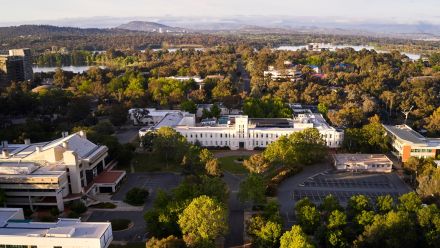Changes in water levels beneath Earth’s surface caused by glacier snowmelt and rainfall could be responsible for triggering small but frequent earthquakes in New Zealand’s central Southern Alps, according to led by The Australian ľ«¶«´«Ă˝app University (ANU).
The scientists found that the frequency of the microearthquakes – small quakes that are typically too weak to be felt by humans – that occurred in parts of the central Southern Alps increased during warmer periods in spring and summer, indicating a seasonal pattern.
According to the study’s lead author Dr Konstantinos Michailos, as temperatures rise during spring and summer months, meltwater from glaciers and seasonal snow from high elevations runs down the mountain and infiltrates the “highly fragmented” mountain bedrock. This leads to seasonal elevated groundwater levels beneath Earth’s surface, which can cause fluid pressure to change in the upper crust.
“Our findings highlight the role of extreme rainfall and glacier dynamics in triggering shallow earthquakes and could provide scientists with a better understanding of the potential drivers of seismic activity in other alpine regions around the world,” Dr Michailos said.
The central Southern Alps – an active mountain range that contains almost all of New Zealand's glaciers – is prone to extreme weather events, including intense rainfall. Dr Michailos said the region can receive upwards of 300 millimetres of rain in just three days.
Dr Michailos said seasonal snowmelt, combined with heavy rainfall events, could elevate water levels beneath the surface and increase pore-fluid pressure in the crust, which in turn could be responsible for triggering frequent microquakes in the region.
“New Zealand’s central Southern Alps is a tectonically active region and lies next to the Alpine Fault, the South Island’s most significant source of seismic hazard,” Dr Michailos said.
“We found that some of these shallow-depth earthquakes, occurring at depths of between three to six kilometres below sea level, were more frequent during spring and summer. These events correlated with periods of heavy rainfall and were most common near the terminals of glaciers, particularly near the Murchison Glacier.
“We found that a lot of these earthquakes were happening within hours or a day after large rainfall events there – a pattern also documented in other parts of the world such as the European Alps.
“Much like other parts of the world, human-induced climate change has caused the central Southern Alps’ glaciers to shrink in recent decades. This glacial mass loss, combined with seasonal fluctuations of snow accumulation and melt, can redistribute stress in Earth’s crust beyond what tectonic forces alone would cause.”
By collecting seismic data from an array of seismometers that have been operating in the central Southern Alps since 2008, the researchers detected more than 8,000 microearthquakes in the region over a period of 11 years, from 2009 to 2020.
The researchers were especially interested in examining seismic activity detected near four major glaciers: Murchison Glacier, Tasman Glacier, Franz Josef Glacier and Fox Glacier.
The research team plans to visit the central Southern Alps in October of this year to deploy additional seismometers and collect denser seismic data to further expand on the study’s findings. Rainfall gauges and temperature sensors will also be installed.
This new infrastructure is designed to complement existing local seismometers and enhance scientists’ ability to record earthquakes, as well as landslides, avalanches and rockfalls.
The research is published in the journal . This work involved scientists from ANU in collaboration with researchers from New Zealand and Switzerland.


